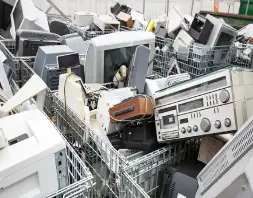 The most touted Union Budget of 2023-24 was announced by the Finance Minister, Ms. Nirmala Sitharaman on February 01, 2023. While Budget has provided several reliefs to the Aam Aadmi, it also grants several reliefs and exemptions for enhanced manufacturing, providing impetus to green technology and mobility and also increased budget allocation for IPR ecosystem in India.
The most touted Union Budget of 2023-24 was announced by the Finance Minister, Ms. Nirmala Sitharaman on February 01, 2023. While Budget has provided several reliefs to the Aam Aadmi, it also grants several reliefs and exemptions for enhanced manufacturing, providing impetus to green technology and mobility and also increased budget allocation for IPR ecosystem in India.
 The Government of Brazil deposited its instrument of accession to the 1999 Geneva Act of the Hague Agreement on February 13, 2023. Brazil is the 71st Contracting Party to the 1999 Act and the 79th member of the Hague Union.
The Government of Brazil deposited its instrument of accession to the 1999 Geneva Act of the Hague Agreement on February 13, 2023. Brazil is the 71st Contracting Party to the 1999 Act and the 79th member of the Hague Union.
 The Competition (Amendment) Bill of 2022 provides a logical approach for gatekeeping of anti-competitive practices already prevailing in the market thereby bringing digital markets within the purview of competition law.
The Competition (Amendment) Bill of 2022 provides a logical approach for gatekeeping of anti-competitive practices already prevailing in the market thereby bringing digital markets within the purview of competition law.
 The Government of India notified the E-Waste (Management) Rules, 2022 which are slated to come into force from April 01, 2023, and the same shall replace the erstwhile E-Wastage Rules, 2016. The Government has further notified new amendments to the Rules of 2022, whereby 2 new entries have been added.
The Government of India notified the E-Waste (Management) Rules, 2022 which are slated to come into force from April 01, 2023, and the same shall replace the erstwhile E-Wastage Rules, 2016. The Government has further notified new amendments to the Rules of 2022, whereby 2 new entries have been added.
Union Budget 2023: Budget Allocation for IPR Ecosystem

By Shilpi Saurav Sharan and Apalka Bareja
The most touted Union Budget of 2023-24 was announced by the Finance Minister, Ms. Nirmala Sitharaman on February 01, 2023. While the Budget has provided several reliefs to the Aam Aadmi, it also grants several reliefs and exemptions for enhanced manufacturing, providing impetus to green technology and mobility and also increased budget allocation for IPR ecosystem in India.
Reportedly, the budgetary allocation for IPR ecosystem has been increased to Rs. 328.981 Crore[1] . As per the Union Budget documents, the Department for Promotion of Industry and Internal Trade (DPIIT) has been allocated a Budget of Rs. 8200.63 Crores as against Rs. 6257 Crores allotted last year. Various IPR related Schemes and programs and budget allocated to them are as under:
| Scheme/ Program | Budget Allocated |
| Start Up India Scheme | Rs. 30 Crores |
| Startup India Seed Fund Scheme | Rs. 160 Crores |
| Intellectual Policy Rights (IPR) Policy Management | Rs. 0.45 Crores |
Union Budget 2023-24- An Impetus to Science, Technology and Innovation
The Budget has allocated Rs. 16,361 Crores to the Ministry of Science and Technology, which is almost Rs. 2000 Crores more than the last Budget 2 . Ms. Nirmala Sitharaman in her Budget Speech while remarking India as an innovative nation, stated that innovations will be promoted in several sectors like Agriculture, wherein Agriculture Accelerator Fund will be set-up to encourage agristartups. The Fund will aim at bringing innovative and affordable solutions for challenges faced by farmers. Similarly, a new programme will be launched to promote research and innovation in pharmaceuticals.
What the Budget has in store for Start-Ups?
To boost Start-Ups in India, Ms. Sitharaman, in her Speech stated that India is now the third largest ecosystem for start-ups globally and ranks second in innovation quality among middle-income countries. To promote and ease business environment in India, the Minister also proposed to extend the date of incorporation for income tax benefits to start-ups from 31.03.23 to 31.3.24 and also to provide the benefit of carry forward of losses on change of shareholding of start-ups from seven years of incorporation to ten years3.
The Union Budget has been progressive in several ways and addresses the monetary concerns faced by the Middle-Income Class group. It is noteworthy to see that India is giving impetus to innovations and has also increased budgetary allocation for Startup Seed fund by 20 Crores this year. It is expected that these initiatives will not only promote the IPR ecosystem in India but will also lead to increased investment and businesses in India.
HERE ARE THE KEY HIGHLIGHTS OF THE BUDGET:
THE ECONOMY IN NUMBERS
- India’s economic growth in the current year is estimated to be 7 percent, highest among all large economies
- The fiscal deficit in FY 2023-24 is estimated at 5.9 per cent of GDP
FOCUS ON MSME
- Credit Guarantee will be revamped starting April 1st 2023, through additional capital of Rs 9,000 Crore
- In Vivad se Vishwas I scheme cases of failure by MSMEs to execute contracts during the Covid period, 95 per cent of the forfeited amount relating to bid or performance security, will be returned to them by government
- Under Vivad se Vishwas II scheme, a voluntary settlement scheme with standardized terms would be introduced to settle contractual disputes of government and government undertakings
- An Entity DigiLocker will be set up for use by MSMEs, large business and charitable trusts
RESILIENCE AMIDST CRISIS
- In Covid-19 pandemic, the scheme to supply free food grains to over 80 crore persons for 28 months
AMRIT KAAL SCHEME
Focus on three things:
- Facilitating ample opportunities for citizens
- Second, providing strong impetus to growth and job creation
- Strengthening macro-economic stability
7 PRIORITIES FOR SAPTARSHI
- Inclusive Development
- Reaching the last mile
- Youth Power
- Financial Sector
- Green Growth
- Unleashing the Potential
- Infrastructure and Investment
- Inclusive Development
SABKA SAATH SABKA VIKAS INCLUSIVE DEVELOPMENT
- Building Digital Public Infrastructure
- ANB Horticulture Clean plant Program to be launched
- Making India Global Hub For Millets under Sree Anna
- Setting up Agriculture Accelerator Fund
- Targeted Funding
- Setting up of widely available storage capacity
LONGER TERM CAPITAL EXPENDITURE
- Capital Investment Outlay increased by 33% to Rs. 10 Lk Cr
- The ratio of capex-to-GDP, which rose to 2.7% in 2022/23, is estimated at 3.3%
- The National Green Hydrogen Mission was allocated Rs. 35,000 crores for priority capital investment towards energy transitions
NEW INCOME TAX SLABS
- 0-3 lakh- nil
- 3-6 lakh- 5%
- 6-9 lakh- 10%
- 9-12 lakh- 15%
- 12-15 lakh- 20%
- 15 lakh+ – 30%
INDIA@100 AND DEVELOPMENT IN IT
- For “Make AI in India and Make AI work for India”, three centres of excellence for Artificial Intelligence will be set-up in top educational institutions
- A National Data Governance Policy will be brought out to enable access to anonymized data
- The KYC process will be simplified adopting a ‘risk-based’ instead of ‘one size fits all’ approach
- One stop solution for identity and address updating maintained by various government agencies, regulators and regulated entities will be established using DigiLocker service and Aadhaar
- 39,000 regulations have been reduced and 3400 legal provisions have been decriminalized for ‘ease of business’
- PAN will be used as the common identifier for all digital systems of specified government agencies
- System of ‘Unified Filing Process’ will be set-up
- To encourage indigenous production of LGD seeds and machines and to reduce import dependency, a research and development grant for the IITs for five years
- A voluntary settlement scheme to resolve contractual disputes In government
- E-Courts for the efficient administration of justice of Rs 7,000 crores
GAMING
- 30 per cent tax on the “net winnings” from online games
- Threshold limit of Rs 10,000 for calculating the tax deducted at source (TDS)
- 30 per cent tax at the time of withdrawal of the winnings or at the end of the financial year
- 194BA for TDS of winnings from online games for online intermediaries
- 115BBJ for computation of taxes for those who earn income from winnings of online games
HEALTH, EDUCATION AND SKILLING
- One hundred and fifty-seven new nursing colleges will be established in co-location with the existing 157 medical college
- Mission to eliminate Sickle Cell Anaemia by 2047
- A National Digital Library for children and adolescents for accessibility of books
PRADHAN MANTRI AAWAS YOJANA
- Pradhan Mantri Aawas Yojana outlay hiked by 66% to Rs 79,000 cr
POWERS UNDER SEZ ACT TO BE DELEGATED TO IFSC AUTHORITY
- Decided to delegate powers under the SEZ Act to IFSCA
- Set up of a single window IT system for registration and approval from IFSCA, SEZ authorities, GSTN, RBI, SEBI and IRDAI
- IFSCA Act will be amended for statutory provisions for arbitration, ancillary services, and avoiding dual regulation under SEZ Act
- Acquisition financing by IFSC Banking Units of foreign banks to be permitted
ENHANCED SEBI’S POWER RELATING TO IMPROVE INVESTORS’ EDUCATION
- SEBI would be empowered to develop, regulate, maintain and enforce norms and standards for education in the National Institute of Securities Markets
- Will allowed recognize award of degrees, diplomas and certificates
CENTRAL DATA PROCESSING CENTRE TO BE INTRODUCED FOR COMPANIES ACT FILLINGS
- A Central Processing Centre would be setup
- For faster response to Companies through centralized handling of various forms filed with field offices
ESTABLISHMENT OF AN IT INTEGRATED IEPFA PORTAL
- Investors can reclaim unclaimed shares and unpaid dividends
- An integrated IT portal will be established
Brazil to Join the Hague System for Registration of Industrial Designs

By Dhruv Mathur and Johny Solomon Raj
The Hague System for the International Registration of Industrial Designs offers a convenient and a feasible solution for conducting smooth business and Design protection, for registering up to 100 designs in 96 countries now, by filing a single international application.
WHO?
The Hague system can be used by:
– Nationals of…
– Anyone with domicile or habitual residence in…
– Anyone with a real and effective industrial or commercial establishment in…
any of the Hague System’s 79 members (referred to as “contracting parties”)– including all countries in the European Union (EU) and the African Intellectual Property Organization (OAPI) – can use the Hague System[4].
WHERE?
A person can secure design protection within any Hague System contracting party. If the applicant wishes to protect a design in a jurisdiction that is not party to the Hague Agreement, then they will have to file a national (or regional) application.
WELCOME BRAZIL!
The Hague System for the International Registration of Industrial Designs welcomes a new participant to its list of signatories. Brazil is the largest economy in Latin America and its accession strengthens the status of the Hague System as a truly global option for securing design protection.
The Government of Brazil deposited its instrument of accession to the 1999 Geneva Act of the Hague Agreement on February 13, 2023. Brazil is the 71st Contracting Party to the 1999 Act and the 79th member of the Hague Union.
BENEFITS
Therefore, with effect from August 1, 2023:
– If a person is a designer or business owner in Brazil, then he/she will be able to seek the protection of his/her designs in any of the 96 countries covered by the Hague System, by filing just one international application.
– If a person is a non-resident, then he/she will be able to secure international design protection in Brazil through WIPO’s Hague System, facilitating the expansion of their business into Latin America.
The Hague System for the International Registration of Industrial Designs is helping the world to come closer with respect to business opportunities, design protection, and expansion of IP cooperation amongst different nations. Brazil joining the Hague System will not just enable the designers/business owners in Brazil to take their designs to other member countries, but also the local owners like SMEs and entrepreneurs to attain a simple design registration in all the contracting countries.
Other benefits of filing design under Hague system:
- Avoid complex and costly domestic formalities.
- Applicants need not worry about the national languages of different countries, currencies or procedures in individual countries or markets. The applicant has to only deal with one international application in one language, pay one set of fees in one currency and deal with just one IP office – WIPO.
- Applicants have an option to schedule publication of their international registration to fit their business strategy, requesting publication only when they are ready to unveil your design on the market.
- Centrally manage your international registration directly through WIPO. One request for change to registration data automatically applies to all designated contracting parties.
- The applicants have a provision to renew their international registration in as many or as few contracting parties, and for as many of the designs, as they wish, directly through WIPO.
- Added advantage of electronic communications – anytime, anywhere – sent to applicants or their appointed representative, keeping the applicants informed about the status of their international registration.
India’s Current Status with respect to the Hague System
As of now, India is not a part of the Hague System, but since it is a part of the Paris Convention for the Protection of Industrial Property, priority can be claimed from a convention application if the design application in India is filed within six months of the priority date of an application, filed in any country or group of countries or member of inter-governmental organizations to which the Paris Convention applies. The same is recognized in the Designs Act in India.
Since, India is a part of Paris Convention, therefore, Article 4 A (2) would be applicable:
Article 4 A (2): Any filing that is equivalent to a regular national filing under the domestic legislation of any country of the Union or under bilateral or multilateral treaties concluded between countries of the Union shall be recognized as giving rise to the right of priority.
Further, Article 4 A (2) (d) speaks:
Since the domestic legislation of the country of the Union where the first application is made decides what a regular national filing is, it is conceivable that the said legislation attributes that quality also to a filing in another country or a filing according to an international treaty to which such country is a party. The latter situation would occur according to the Hague Agreement concerning the International Deposit of Industrial Designs of 1925, revised at London in 1934, because Article 4(4) of that Agreement states that the right of priority established by Article 4 of the Paris Convention will be guaranteed to every design which has been the subject of an international deposit. without requiring compliance with any of the formalities specified in the latter Article. This is, of course, binding on the member States of the Hague Agreement, but would it also oblige other countries, parties to the Paris Convention but not to the Hague Agreemento acknowledge a priority right based on such international deposit or filing? A provision establishing such obligation was introduced at the Revision Conference of London in 1934.
Therefore, priority may be claimed for the Indian national filings based on the international design application (under the Hague System), as well as from a Community design filing.
Digital Competition Law: India

By Rupin Chopra and Vidhi Oberoi
Introduction
The Competition Act, 2002 (hereinafter referred to as the “Act”) was enacted to prevent practices having an adverse effect on competition, to promote and sustain competition in markets, to protect the interests of consumers, and to ensure freedom of trade carries on by other participants in markets in India. The Act basically governs the traditional Indian markets with digital market competition being outside its purview, so far. However, with changing scenarios and the evolution of Digital Markets in India, the Indian Government has felt the need to regulate the market ruled by Big Tech Firms.
India is, thus, ready to follow the European Union for enacting the Digital Markets Act which introduces a variety of prohibitions and obligations on “Big-tech” in order to address concerns about contestability and fairness in the digital economy. New age development in digital markets necessitates the need to regulate competition and prevent anti-competitive practices that might be adopted by firms.
Competition Law: Current Regulatory Framework
The Act defines combinations as the acquisition, merger, or amalgamation of one or more enterprises if they meet certain criteria based on their assets or turnover. Consequently, such combinations meeting the set criteria have to obtain approval from the Competition Commission of India (hereinafter referred to as the “CCI”). Acquisitions in digital markets are value based on data or certain business innovations of the company being acquired. The company to be acquired in such a transaction may not have a large asset base and may be in a line where products/services are given for free. A classic example of such a deal is where Facebook acquired WhatsApp in 2014 for approximately USD 19 billion. The deal required no clearance form CCI due to low asset base though India being a major market for WhatsApp. Such transactions have a huge impact on the competition and CCI currently lacks the legal framework to evaluate deals that do not fall within the ambit of the stipulated criteria based on assets or turnover.
The Competition (Amendment) Bill, 2022
Indian markets have grown significantly along with the changes in business operations with the rapid emergence of digital internet-based companies. In 2018, the Ministry of Corporate Affairs constituted a Competition Law Review Committee to ensure that the Competition Act is in line with India’s economic fundamentals. The Committee noted that certain market practices are not covered by the current regulatory framework, therefore, in its report, the Committee suggested several suggestions dealing with matters of market competition. The Competition (Amendment) Bill, 2022, (hereinafter referred to as the “Bill”) was proposed after reviewing the recommendations proposed by the Competition Law Review Committee. The Bill seeks to broaden the scope of anti-competitive agreements, evaluate combinations based on the value of transactions, and introduces a settlement and commitment framework to reduce litigation.
Proposed key features- Digital Competition Bill
- Regulation of combination based on transaction value – By reinforcing the present prohibition on combinations, the bill expands the definition of combinations to include transactions with a value above INR 2000 crore3. The Bill, thus, proposes to introduce ‘value of transaction’ as criteria for notifying combinations in certain cases like those of digital markets provided that the parties to transactions have ‘substantial business operations in India’.
- Time limit for approval – Bill reduces the time limit for the CCI to approve a combination from 210 days to 150 days.
- Settlement and Commitment in anti-competitive proceedings – The Act provides that the CCI may institute proceedings against enterprises on grounds of entering in to anti-competitive agreements or abuse of dominant position. Further, the Bill seeks to add and permit the CCI to close the proceedings if the enterprise offers for: (i) settlements which may involve payment, (ii) or commitments which may be structural or behavioral in nature. The manner and framework of settlement and commitment are to be specified by the CCI itself.
- Decriminalization of certain offences – The existing provision for fine/imprisonment under the Act by the National Company Law Appellate Tribunal (NCLAT) is proposed to be replaced with the punishment for contempt, in accordance with the provisions of the Contempt of Courts Act, 1971, and the word ‘fine’ is replaced with ‘penalty’.
- Appointment of Director General – The power to appoint the Director-General by the Commission instead of Central Government has also been proposed.
Conclusion
The Bill is an important step towards developing India’s anti-competitive regime which effectively responds to the changing nature of modern markets. The Bill further provides a logical approach for gatekeeping of anti-competitive practices already prevailing in the market thereby bringing digital markets within the purview of competition law and vis-à-vis provide speedy approvals to transactions that meet the set criteria. The Bill has been framed not only keeping in mind the antitrust violations but also draws inspiration from international laws such as European Union’s Digital Markets Act to regulate anti-trust compliance of large tech-companies in India.
[3] https://www.forbes.com/sites/parmyolson/2014/10/06/facebook-closes-19-billion-whatsapp-deal/?sh=34cb98ae5c66
[4] https://prsindia.org/billtrack/the-competition-amendment-bill-2022
Rachita Thakur, Junior Associate at S.S. Rana & Co. has assisted in the research of this Article.
Related Posts
Competition Amendment Bill, 2022- Settlement and Commitment Scheme
Competition (Amendment) Bill, 2022: Salient features of the Bill
Amendment of E-Waste (Management) Rules, 2022- India

By Apalka Bareja
The Government of India, on November 2, 2022, notified the E-Waste (Management) Rules, 2022 replacing the erstwhile E-Waste (Management) Rules, 2016. The Rules will come into force from April 01, 2023.
The primary object of the rules is to bring down the use of hazardous substances (such as lead, mercury, and cadmium) in manufacturing of electrical and electronic equipment that have an adverse impact on human health and the environment.
Pursuant to the aforesaid objective, the Government of India vide its notification dated- January 30, 2023, notified new amendments to the E-Waste (Management) Rules, 2022.
The notification has introduced amendments in the following:
• In rule 16 (Reduction in the use of hazardous substances in the manufacture of electrical and electronic equipment and their components or consumables or parts or spares) sub-rule 5 which provides for the producers to give details regarding reduction of hazardous substances in their equipment and their components or consumables or spares, the words ‘‘in the product user documentation’’, have been substituted with the words ‘‘as and when required by the Central Pollution Control Board’’.
• Addition of two new entries in Schedule-II (Applications, which are exempted from the requirements of sub-rule (1) of rule 16) , after entry no. 35, namely
(i) ‘‘36. Cadmium and lead in Solar panels/cells, solar Photovoltaic panels/cells/modules as listed in Schedule – I”.
(ii) “37. Lead in Medical Devices (with the exception of all implanted and infected products) as listed in Schedule – I.’’.
The aforementioned amendments shall be effective from April 01, 2023.
Shanatam Sharma, Intern at S.S. Rana & Co. has assisted in the research of this Article.
https://www.indiabudget.gov.in/doc/eb/vol1.pdf
The Ministry of Science & Technology received a Budget of Rs. 14,217.46 Crores in 2022-23
https://www.indiabudget.gov.in/doc/budget_speech.pdf
Related Posts
[1]New TDS Norms on E-Gaming Bounty- Budget
[2]Union Budget- 2021-22- Key Highlights
[3]Battery Waste Management Rules, 2022- Registration and Regulatory Compliances
[4]India: Responsibility of the E-waste Producer
India: Responsibility of Importers under E-Waste (Management) Rules, 2016


